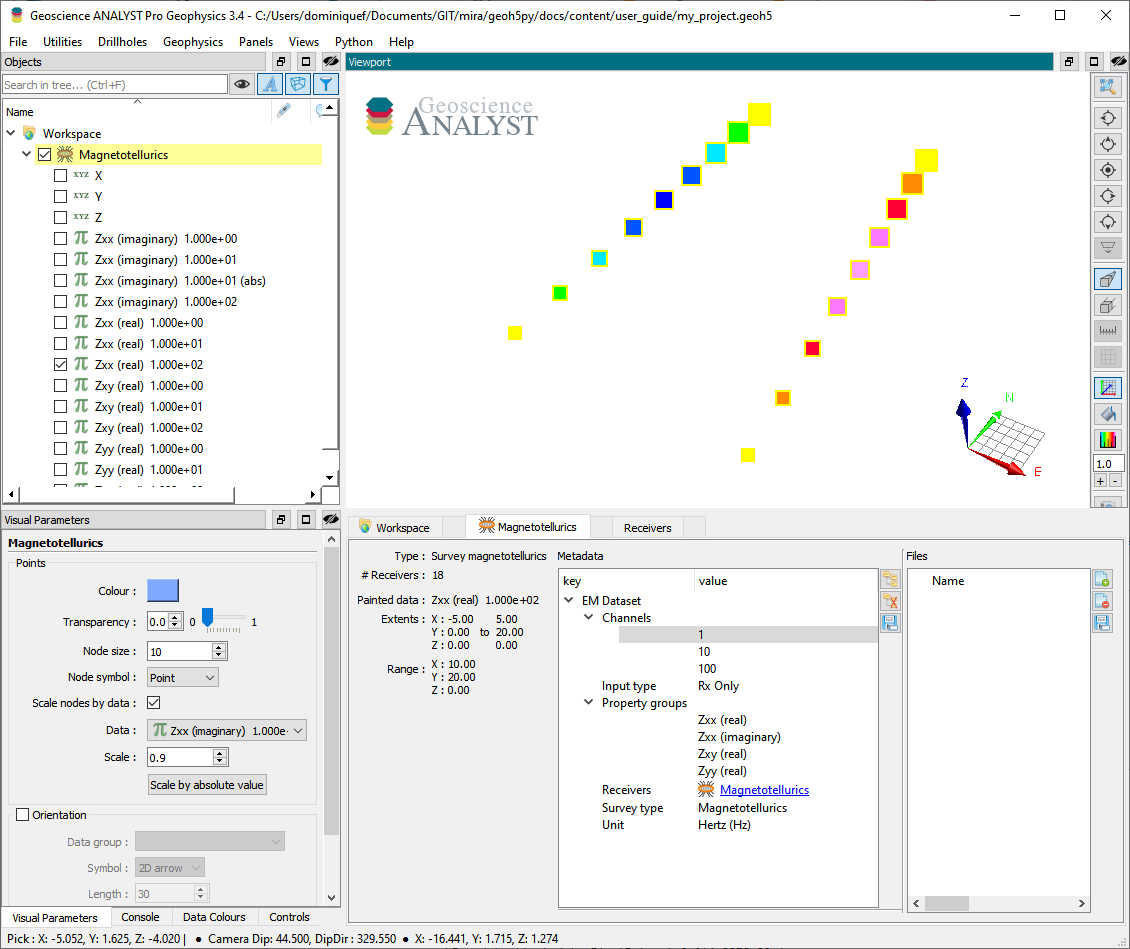Magnetotellurics¶
This object can be used to store magnetotelluric (MT) surveys - a natural-source geophysical method. Data are provided in the frequency-domain as point source measurements of either impedances or apparent resistity/phase.
The following example shows how to generate an MT survey with associated data stored in geoh5 format and accessible from Geoscience ANALYST.

[1]:
import numpy as np
from geoh5py.objects import MTReceivers
from geoh5py.workspace import Workspace
# Create a new project
workspace = Workspace("my_project.geoh5")
# Define a synthetic survey with receivers on 2 lines, 60 m apart
x_loc, y_loc = np.meshgrid(np.linspace(-5, 5, 2), np.linspace(0.0, 20.0, 9))
vertices = np.c_[x_loc.ravel(), y_loc.ravel(), np.zeros_like(x_loc).ravel()]
# Create the survey from vertices
mt_survey = MTReceivers.create(workspace, vertices=vertices)
Only receivers are needed to define the survey as MT uses the ambient electromagntic field of the Earth - no transmitters (source) required.
Metadata¶
Along with the MTReceivers, the metadata contains all the necessary information to define the geophysical experiment.
[2]:
mt_survey.metadata
[2]:
{'EM Dataset': {'Channels': [],
'Input type': 'Rx only',
'Property groups': [],
'Receivers': UUID('0aa12b37-fe20-41b6-a381-0894a19e9cbf'),
'Survey type': 'Magnetotellurics',
'Unit': 'Hertz (Hz)'}}
Channels¶
List of frequencies at which the data are provided.
[3]:
mt_survey.channels = [1.0, 10.0, 100.0]
Input type¶
Generic label used in the geoh5 standard for all EM survey entities. Restricted to Rx only in the case of natural sources methods.
Property groups¶
List of PropertyGroups defining the various data components (e.g. Zxx (real), Zxy (imag), …). It is not required to supply all components of the impedence tensor, but it is expected that each component contains a list of data channels of length and in the same order as the Channels (one Data per frequency).
The class method add_components_data can help users add data from nested dictionaries. Below is an example using four components:
[4]:
# Arbitrary data generator using sine functions
def data_fun(c, f):
return (c + 1.0) * np.sin(f * np.pi * (x_loc * y_loc).ravel() / 200.0)
# Create a nested dictionary of component and frequency data.
data = {
component: {
f"{component}_{freq}": {
"values": (ff + 1) * 1000.0
+ (cc + 1) * 100.0
+ np.arange(vertices.shape[0])
}
for ff, freq in enumerate(mt_survey.channels)
}
for cc, component in enumerate(
[
"Zxx (real)",
"Zxx (imaginary)",
"Zxy (real)",
"Zxy (imaginary)",
"Zyx (real)",
"Zyx (imaginary)",
"Zyy (real)",
"Zyy (imaginary)",
]
)
}
mt_survey.add_components_data(data)
[4]:
[<geoh5py.groups.property_group.PropertyGroup at 0x7f8e07d41e70>,
<geoh5py.groups.property_group.PropertyGroup at 0x7f8e07d02110>,
<geoh5py.groups.property_group.PropertyGroup at 0x7f8dfb95a3b0>,
<geoh5py.groups.property_group.PropertyGroup at 0x7f8dfb95ac50>,
<geoh5py.groups.property_group.PropertyGroup at 0x7f8dfb95b4c0>,
<geoh5py.groups.property_group.PropertyGroup at 0x7f8dfb95bd00>,
<geoh5py.groups.property_group.PropertyGroup at 0x7f8dfb95b3d0>,
<geoh5py.groups.property_group.PropertyGroup at 0x7f8dfb95bc10>]
Metadata are updated immediately to reflect the addition of components:
[5]:
mt_survey.metadata
[5]:
{'EM Dataset': {'Channels': [1.0, 10.0, 100.0],
'Input type': 'Rx only',
'Property groups': ['Zxx (real)',
'Zxx (imaginary)',
'Zxy (real)',
'Zxy (imaginary)',
'Zyx (real)',
'Zyx (imaginary)',
'Zyy (real)',
'Zyy (imaginary)'],
'Receivers': UUID('0aa12b37-fe20-41b6-a381-0894a19e9cbf'),
'Survey type': 'Magnetotellurics',
'Unit': 'Hertz (Hz)'}}
Data channels associated with each component can be quickly accessed through the BaseEMSurvey.components property:
[6]:
mt_survey.components
[6]:
{'Zxx (real)': [<geoh5py.data.float_data.FloatData at 0x7f8e07d42530>,
<geoh5py.data.float_data.FloatData at 0x7f8dfb958d60>,
<geoh5py.data.float_data.FloatData at 0x7f8dfb958df0>],
'Zxx (imaginary)': [<geoh5py.data.float_data.FloatData at 0x7f8dfb958fd0>,
<geoh5py.data.float_data.FloatData at 0x7f8dfb958eb0>,
<geoh5py.data.float_data.FloatData at 0x7f8dfb95a080>],
'Zxy (real)': [<geoh5py.data.float_data.FloatData at 0x7f8dfb959420>,
<geoh5py.data.float_data.FloatData at 0x7f8dfb959f00>,
<geoh5py.data.float_data.FloatData at 0x7f8dfb95a2f0>],
'Zxy (imaginary)': [<geoh5py.data.float_data.FloatData at 0x7f8dfb95a680>,
<geoh5py.data.float_data.FloatData at 0x7f8dfb959150>,
<geoh5py.data.float_data.FloatData at 0x7f8dfb95ab90>],
'Zyx (real)': [<geoh5py.data.float_data.FloatData at 0x7f8dfb95aef0>,
<geoh5py.data.float_data.FloatData at 0x7f8dfb95a2c0>,
<geoh5py.data.float_data.FloatData at 0x7f8dfb95b400>],
'Zyx (imaginary)': [<geoh5py.data.float_data.FloatData at 0x7f8dfb95b760>,
<geoh5py.data.float_data.FloatData at 0x7f8dfb95ab60>,
<geoh5py.data.float_data.FloatData at 0x7f8dfb95bc40>],
'Zyy (real)': [<geoh5py.data.float_data.FloatData at 0x7f8dfb95bfa0>,
<geoh5py.data.float_data.FloatData at 0x7f8dfb95bd30>,
<geoh5py.data.float_data.FloatData at 0x7f8dfb9e0490>],
'Zyy (imaginary)': [<geoh5py.data.float_data.FloatData at 0x7f8dfb9e0820>,
<geoh5py.data.float_data.FloatData at 0x7f8dfb9e0ca0>,
<geoh5py.data.float_data.FloatData at 0x7f8dfb9e0c70>]}
Receivers¶
Generic label used in the geoh5 standard for EM survey to identify the receiver entity. Restricted to itself in the case of MTReceivers.
Survey type¶
Label identifier for Magnetotellurics survey type.
Unit¶
Units for frequency sampling of the data: Hertz (Hz), KiloHertz (kHz), MegaHertz (MHz) or Gigahertz (GHz).
[7]:
workspace.close()